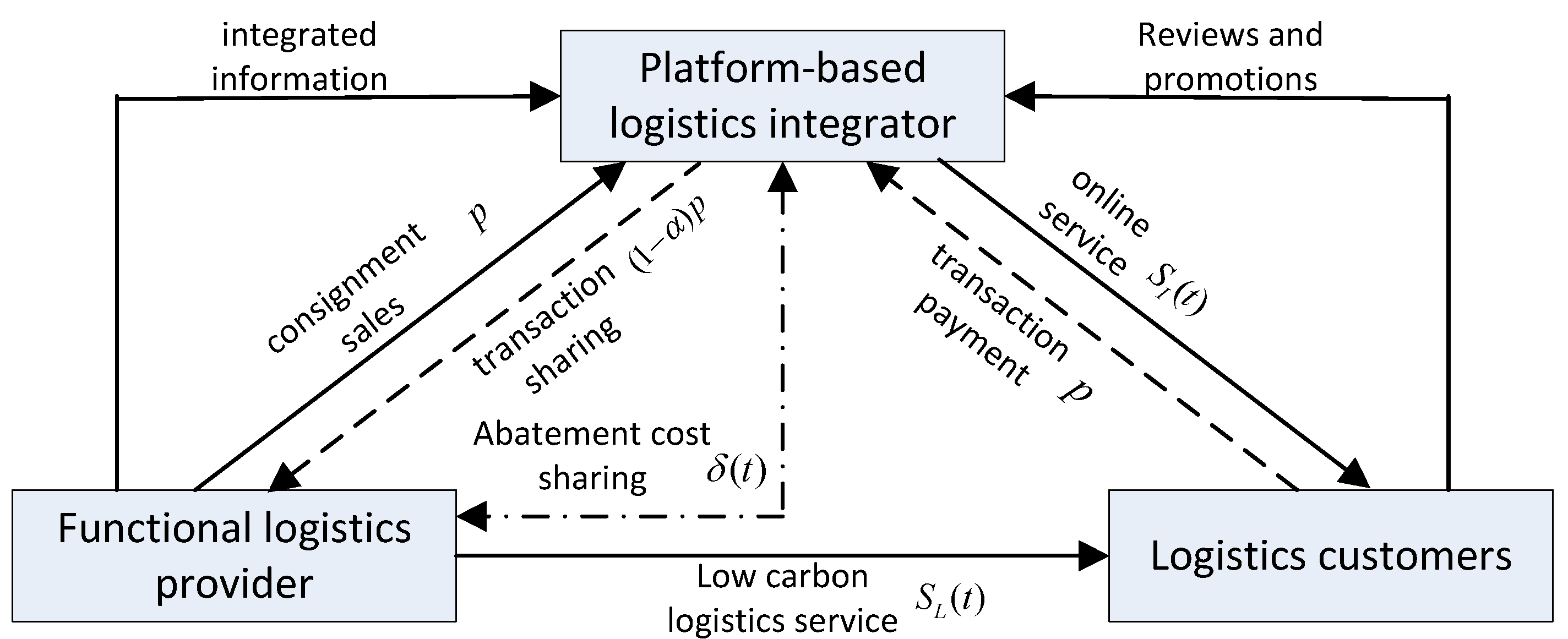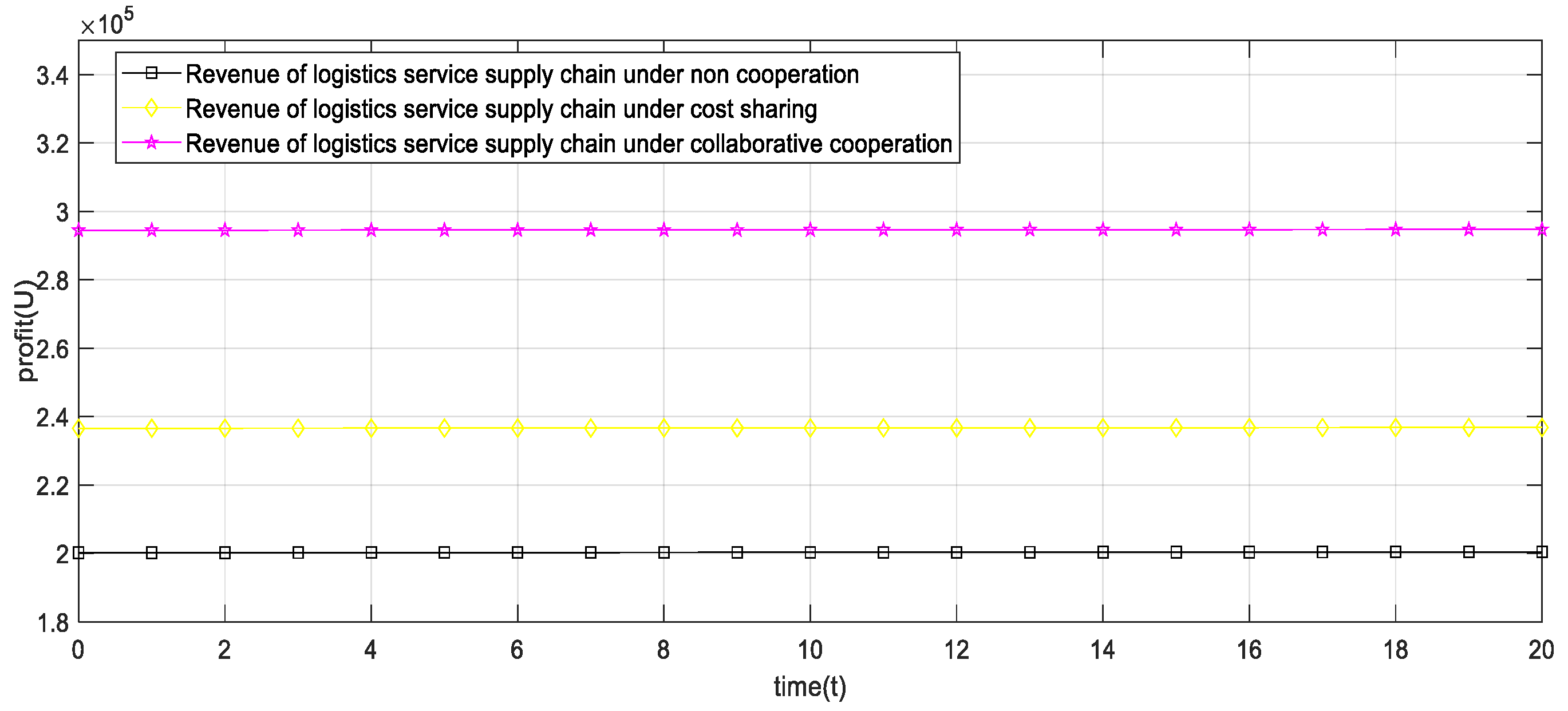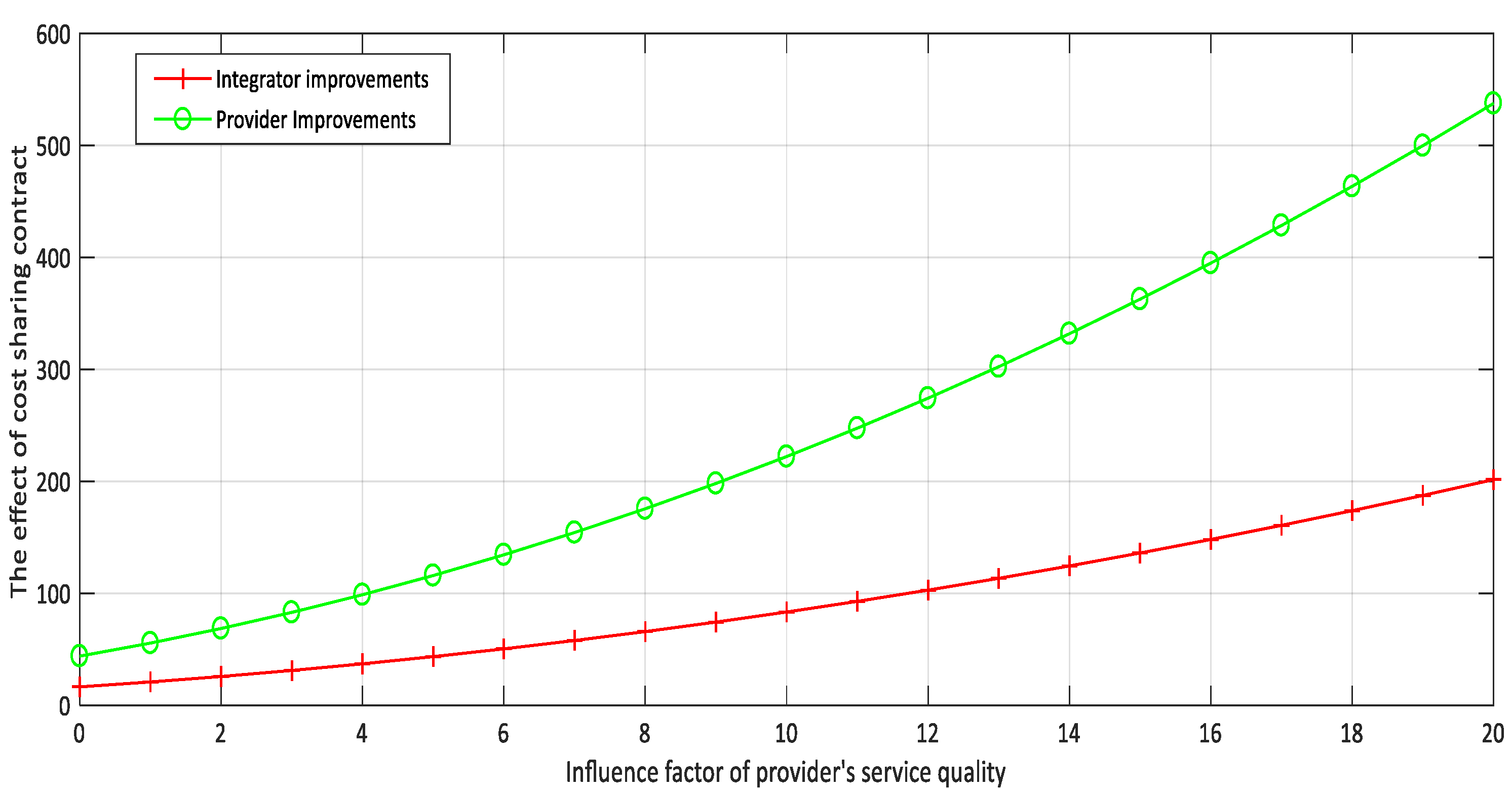Research on the Emission Reduction Decision of Cost-Sharing Logistics Service Supply Chain in the O2O Model
Abstract
:1. Introduction
- (1)
- What kind of relationship exists between online and onsite abatement services and the platform brand image of the logistics service supply chain in the O2O mode? How do the two affect the market demand for logistics services?
- (2)
- What are the differences in the returns of the three decision game models under the O2O model? Namely, when Nash non-cooperative equilibrium is in the non-cooperative mode, the Stackelberg game in the cost-sharing mechanism, and the Nash cooperative game, can the provider and the integrator coordinate the emission reduction benefits of the logistics service supply chain?
- (3)
- How do the online-onsite abatement services affect the total platform brand image and logistics service supply chain revenue over time? What are the changes in the service integrator’s and provider’s revenue before and after the emission reduction cost sharing?
- (4)
- What are the effects of the important factors, such as the cost of logistics emission reduction and the impact of emission reduction service on market demand and integrator’s brand image, on the cost-sharing Pareto contract of logistics emission reduction in the O2O logistics service supply chain?
2. Literature Review
2.1. Coordinated Decision-Making of Logistics Service Supply Chain under the O2O Model
2.2. A Differential Game Decision Model for Supply Chain Abatement
2.3. Supply Chain Abatement Game Model Based on the Cost-Sharing Mechanism
3. Problem Description and Model Assumptions
3.1. Problem Description
3.2. Model Assumptions
4. Comparison of Game Models for Emission Reduction in Logistics Service Supply Chain under the O2O Model
4.1. Non-Cooperative Nash Game Model
4.2. The Stackelberg Game of Sharing Logistics Emission Reduction Costs
4.3. Centralized Decision-Making for Emission Reduction in Logistics Service Supply Chain under the O2O Model
5. Comparative Analysis of Equilibrium Results
- (1)
- Comparison of optimal emission reduction services for integrators.
- (2)
- Comparison of optimal emission reduction services of providers:(), logistics abatement cost-sharing factor,().
- (1)
- It can be known from Equations (1), (16), and (29) that:, proof completed.
- (2)
- It can be known from Equations (2), (17), and (30) that:, if , then ; if , then . Similarly, it is easy to get , proof completed.
- (3)
- It can be known from Equations (2), (17), and (18) that:, proof completed.
- (1)
- Comparison of the optimal benefits of emission reduction for integrators:
- (2)
- Comparison of the optimal benefits of emission reduction for providers:();().
- (3)
- Comparison of emission reduction and value-added benefits of integrators and providers:,;,.
- (4)
- Comparison of emission reduction benefits of logistics service supply chain:When ,When,.
- (1)
- From the optimal value Expressions (13) and (26), we can get:
- (2)
- From the optimal value Expressions (14) and (27), we can get:If , then ; If , then .
- (3)
- From Equations (36) and (37), we can get:If , then ;If , then .
- (4)
- From Equations (15), (28), and (35), we can get:Now, if , then ; If , . Similarly, it can easily get. □
6. Numerical Simulation
6.1. Benefit Analysis
6.2. Improvement Effect of Logistics Emission Reduction Cost-Sharing Contract
7. Conclusions and Implications
7.1. Conclusions
7.2. Managerial Implications
7.3. Limitations and Future Research Directions
Author Contributions
Funding
Institutional Review Board Statement
Informed Consent Statement
Data Availability Statement
Acknowledgments
Conflicts of Interest
References
- Liu, W.H.; Xu, X.C.; Ren, Z.X.; Peng, Y. An emergency order allocation model based on multi-provider in two-echelon logistics service supply chain. Supply Chain Manag. 2011, 16, 391–400. [Google Scholar]
- Choi, T.M. Internet based elastic logistics platforms for fashion quick response systems in the digital era. Transp. Res. Part E Logist. Transp. Rev. 2020, 143, 102096. [Google Scholar] [CrossRef]
- Qin, X.; Liu, Z.; Tian, L. The strategic analysis of logistics service sharing in an e-commerce platform. Omega 2020, 92, 102153. [Google Scholar] [CrossRef]
- Niu, B.; Li, Q.; Mu, Z.; Chen, L.; Ji, P. Platform logistics or self-logistics? Restaurants’ cooperation with online food-delivery platform considering profitability and sustainability. Int. J. Prod. Econ. 2021, 234, 108064. [Google Scholar]
- Tang, S.; Wang, W.; Yan, H.; Hao, G. Low carbon logistics: Reducing shipment frequency to cut carbon emissions. Int. J. Prod. Econ. 2015, 164, 339–350. [Google Scholar] [CrossRef]
- Wang, X.; Dong, F. The dynamic relationships among growth in the logistics industry, energy consumption, and carbon emission: Recent evidence from China. J. Pet. Explor. Prod. Technol. 2022, 1–16. [Google Scholar] [CrossRef]
- Xiao, R.; Pan, L.; Xiao, H.; Xiao, H.; Zhu, Z. Research of Intelligent Logistics and High-Quality Economy Development for Yangtze River Cold Chain Shipping Based on Carbon Neutrality. J. Mar. Sci. Eng. 2022, 10, 1029. [Google Scholar] [CrossRef]
- Mak, S.L.; Wong, Y.M.; Ho, K.C.; Lee, C.C. Contemporary Green Solutions for the Logistics and Transportation Industry—With Case Illustration of a Leading Global 3PL Based in Hong Kong. Sustainability 2022, 14, 8777. [Google Scholar] [CrossRef]
- Zhang, A.; Alvi, M.F.; Gong, Y.; Wang, J.X. Overcoming barriers to supply chain decarbonization: Case studies of first movers. Resour. Conserv. Recycl. 2022, 186, 106536. [Google Scholar] [CrossRef]
- Ji, S.; Sun, Q. Low-carbon planning and design in B&R logistics service: A case study of an e-commerce big data platform in China. Sustainability 2017, 9, 2052. [Google Scholar] [CrossRef] [Green Version]
- Liu, W.; Wang, M.; Zhu, D.; Zhou, L. Service capacity procurement of logistics service supply chain with demand updating and loss-averse preference. Appl. Math. Model. 2019, 66, 486–507. [Google Scholar] [CrossRef]
- Liu, W.H.; Xie, D. Quality decision of the logistics service supply chain with service quality guarantee. Int. J. Prod. Res. 2013, 51, 1618–1634. [Google Scholar] [CrossRef]
- Du, N.; Han, Q. Pricing and service quality guarantee decisions in logistics service supply chain with fairness concern. Asia-Pac. J. Oper. Res. 2018, 35, 1850036. [Google Scholar] [CrossRef]
- Yu, Y.; Xiao, T. Pricing and cold-chain service level decisions in a fresh agri-products supply chain with logistics outsourcing. Comput. Ind. Eng. 2017, 111, 56–66. [Google Scholar] [CrossRef]
- Zhang, Y.; Rong, F.; Wang, Z. Research on cold chain logistic service pricing—Based on tripartite Stackelberg game. Neural Comput. Appl. 2020, 32, 213–222. [Google Scholar] [CrossRef]
- Mangano, G.; Zenezini, G.; Cagliano, A.C.; De Marco, A. The dynamics of diffusion of an electronic platform supporting City Logistics services. Oper. Manag. Res. 2019, 12, 182–198. [Google Scholar] [CrossRef]
- Zhou, Z.; Wan, X. Does the Sharing Economy Technology Disrupt Incumbents? Exploring the Influences of Mobile Digital Freight Matching Platforms on Road Freight Logistics Firms. Prod. Oper. Manag. 2022, 31, 117–137. [Google Scholar]
- Liu, W.; Long, S.; Liang, Y.; Wang, J.; Wei, S. The influence of leadership and smart level on the strategy choice of the smart logistics platform: A perspective of collaborative innovation participation. Ann. Oper. Res. 2021, 1–43. [Google Scholar] [CrossRef]
- Qu, F.; Liu, Z. Research on the Information Platform Establishment of Logistics Services Supply Chain from the Perspective of Tripartite Coordination. In Proceedings of the 2017 4th International Conference on Education, Management and Computing Technology (ICEMCT 2017), Hangzhou, China, 15–16 April 2017; Atlantis Press: Amsterdam, The Netherlands, 2017; pp. 489–492. [Google Scholar]
- Yang, Y.; Pan, S.; Ballot, E. Mitigating supply chain disruptions through interconnected logistics services in the Physical Internet. Int. J. Prod. Res. 2017, 55, 3970–3983. [Google Scholar] [CrossRef]
- Tang, C.S.; Veelenturf, L.P. The strategic role of logistics in the industry 4.0 era. Transp. Res. Part E Logist. Transp. Rev. 2019, 129, 1–11. [Google Scholar] [CrossRef]
- Lin, Y.; Chen, A.; Yin, Y.; Li, Q.; Zhu, Q.; Luo, J. A framework for sustainable management of the platform service supply chain: An empirical study of the logistics sector in China. Int. J. Prod. Econ. 2021, 235, 108112. [Google Scholar] [CrossRef]
- Zhou, Y.; Bao, M.; Chen, X.; Xu, X. Co-op advertising and emission reduction cost sharing contracts and coordination in low-carbon supply chain based on fairness concerns. J. Clean. Prod. 2016, 133, 402–413. [Google Scholar] [CrossRef]
- He, P.; He, Y.; Shi, C.V.; Xu, H.; Zhou, L. Cost-sharing contract design in a low-carbon service supply chain. Comput. Ind. Eng. 2020, 139, 106160. [Google Scholar] [CrossRef]
- Hwang, H.S. Design of supply-chain logistics system considering service level. Comput. Ind. Eng. 2002, 43, 283–297. [Google Scholar] [CrossRef]
- Ma, F.; Xue, H.; Yuen, K.F.; Sun, Q.; Zhao, S.; Zhang, Y.; Huang, K. Assessing the vulnerability of logistics service supply chain based on complex network. Sustainability 2020, 12, 1991. [Google Scholar] [CrossRef] [Green Version]
- Yuan, Y.; Ju, S.D.; Ding, G.Z. Functional logistics service provider selection for online retailing logistics service supply chain (LSSC). J. Balk. Tribol. Assoc. 2016, 22, 2136–2144. [Google Scholar]
- Zhang, G.; Wang, X.; Meng, Z.; Zhang, Q.; Wu, K. Operation decision of logistics service supply chain: Considering interruption probability in emergencies. Kybernetes 2021. [Google Scholar] [CrossRef]
- Zhong, Y.; Guo, F.; Tang, H.; Chen, X. Research on coordination complexity of E-commerce logistics service supply chain. Complexity 2020, 2020, 7031543. [Google Scholar] [CrossRef]
- Lin, M.S.M.; Potter, A.; Pettit, S. Relationship heterogeneity in Taiwanese maritime logistics service supply chains. Supply Chain Manag. Int. J. 2021, 26, 385–401. [Google Scholar] [CrossRef]
- Liu, W.; Wei, W.; Zhu, D. Service capacity procurement in logistics service supply chain with demand updating and reciprocal behaviour. Eur. J. Ind. Eng. 2021, 15, 35–66. [Google Scholar] [CrossRef]
- Zhang, G.; Wang, X.; Wang, Y.; Kang, J. Research on the Resilient Evolutionary Game of Logistics Service Supply Chain with Government Participation. Mathematics 2022, 10, 630. [Google Scholar] [CrossRef]
- Dai, H.; Cui, Y.W.; Guo, L.F.; Ma, J.Q. Construction and Application Analysis of Logistics Service Supply Chain Based on Block Chain. J. Environ. Prot. Ecol. 2019, 20, 1554–1564. [Google Scholar]
- Liu, H.; Chen, H.; Zhang, H.; Liu, H.; Yu, X.; Zhang, S. Contract Design of Logistics Service Supply Chain Based on Smart Transformation. Sustainability 2022, 14, 6261. [Google Scholar] [CrossRef]
- Liu, X.; Zhang, K.; Chen, B.; Zhou, J.; Miao, L. Analysis of logistics service supply chain for the One Belt and One Road initiative of China. Transp. Res. Part E Logist. Transp. Rev. 2018, 117, 23–39. [Google Scholar] [CrossRef]
- Bai, Q.; Jin, M.; Xu, X. Effects of carbon emission reduction on supply chain coordination with vendor-managed deteriorating product inventory. Int. J. Prod. Econ. 2019, 208, 83–99. [Google Scholar] [CrossRef]
- Wang, Q.; Li, B.; Chen, B.; Cheng, Y.; Wang, Z. Implication of take-back and carbon emission capacity regulations on remanufacturing in a competitive market. J. Clean. Prod. 2021, 325, 129231. [Google Scholar] [CrossRef]
- Wang, Y.; Fan, R.; Shen, L.; Miller, W. Recycling decisions of low-carbon e-commerce closed-loop supply chain under government subsidy mechanism and altruistic preference. J. Clean. Prod. 2020, 259, 120883. [Google Scholar] [CrossRef]
- Ma, C.; Yang, H.; Zhang, W.; Huang, S. Low-carbon consumption with government subsidy under asymmetric carbon emission information. J. Clean. Prod. 2021, 318, 128423. [Google Scholar] [CrossRef]
- Koberg, E.; Longoni, A. A systematic review of sustainable supply chain management in global supply chains. J. Clean. Prod. 2019, 207, 1084–1098. [Google Scholar] [CrossRef]
- Mohaghegh, M.; Blasi, S.; Gossler, A. Dynamic capabilities linking lean practices and sustainable business performance. J. Clean. Prod. 2021, 322, 129073. [Google Scholar] [CrossRef]
- Yang, Y.; Xu, X. A differential game model for closed-loop supply chain participants under carbon emission permits. Comput. Ind. Eng. 2019, 135, 1077–1090. [Google Scholar] [CrossRef]
- Sun, L.; Cao, X.; Alharthi, M.; Zhang, J. Carbon emission transfer strategies in supply chain with lag time of emission reduction technologies and low-carbon preference of consumers. J. Clean. Prod. 2020, 264, 121664. [Google Scholar] [CrossRef]
- Wei, J.; Wang, C. Improving interaction mechanism of carbon reduction technology innovation between supply chain enterprises and government by means of differential game. J. Clean. Prod. 2021, 296, 126578. [Google Scholar] [CrossRef]
- He, L.; Yuan, B.; Bian, J.; Lai, K.K. Differential game theoretic analysis of the dynamic emission abatement in low-carbon supply chains. Ann. Oper. Res. 2021, 1–39. [Google Scholar] [CrossRef]
- Wu, P.; Yin, Y.; Li, S.; Huang, Y. Low-Carbon Supply Chain Management Considering Free Emission Allowance and Abatement Cost Sharing. Sustainability 2018, 10, 2110. [Google Scholar] [CrossRef]
- Yu, C.; Wang, C.; Zhang, S. Advertising cooperation of dual-channel low-carbon supply chain based on cost-sharing. Kybernetes 2019, 49, 1169–1195. [Google Scholar] [CrossRef]
- Liu, W.; Wang, Y. Quality control game model in logistics service supply chain based on different combinations of risk attitude. Int. J. Prod. Econ. 2015, 161, 181–191. [Google Scholar] [CrossRef]
- Nagurney, A.; Yu, M. Sustainable fashion supply chain management under oligopolistic competition and brand differentiation. Int. J. Prod. Econ. 2012, 135, 532–540. [Google Scholar] [CrossRef]






Publisher’s Note: MDPI stays neutral with regard to jurisdictional claims in published maps and institutional affiliations. |
© 2022 by the authors. Licensee MDPI, Basel, Switzerland. This article is an open access article distributed under the terms and conditions of the Creative Commons Attribution (CC BY) license (https://creativecommons.org/licenses/by/4.0/).
Share and Cite
Zhang, G.; Wang, X.; Zhang, Y.; Kang, J. Research on the Emission Reduction Decision of Cost-Sharing Logistics Service Supply Chain in the O2O Model. Sustainability 2022, 14, 13247. https://doi.org/10.3390/su142013247
Zhang G, Wang X, Zhang Y, Kang J. Research on the Emission Reduction Decision of Cost-Sharing Logistics Service Supply Chain in the O2O Model. Sustainability. 2022; 14(20):13247. https://doi.org/10.3390/su142013247
Chicago/Turabian StyleZhang, Guangsheng, Xiao Wang, Yu Zhang, and Jiayun Kang. 2022. "Research on the Emission Reduction Decision of Cost-Sharing Logistics Service Supply Chain in the O2O Model" Sustainability 14, no. 20: 13247. https://doi.org/10.3390/su142013247
APA StyleZhang, G., Wang, X., Zhang, Y., & Kang, J. (2022). Research on the Emission Reduction Decision of Cost-Sharing Logistics Service Supply Chain in the O2O Model. Sustainability, 14(20), 13247. https://doi.org/10.3390/su142013247





